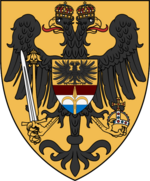House de Weluta
This article is a work-in-progress because it is incomplete and pending further input from an author. Note: The contents of this article are not considered canonical and may be inaccurate. Please comment on this article's talk page to share your input, comments and questions. |
| House de Weluta House of Urcea, House of Caroline, Carolines | |
|---|---|
| Royal House | |
 | |
| Country | Urcea |
| Founded | 14th Century |
| Current head | King Riordan VIII |
| Titles | List of titles
|
| Style(s) | His Most Christian Majesty (for the King) His/Her/Your Christian Highness (for close relatives of the King) His/Her/Your Excellency (for all other family members) |
| Motto | Via et veritas et vita (The way, the truth, and the life) |
| Estate(s) | List of properties owned |
The House de Weluta is the reigning royal house of the Apostolic Kingdom of Urcea as well as the Kingdoms of Talionia and New Harren. The house originated as a cadet branch of the Julian dynasty. Emerging victorious from the Saint's War and Great Interregnum in the 14th Century, the House de Weluta has ruled over Urcea with two notable interruptions since. Several of its members, beginning with Emperor Leo III, have reigned as Emperor of the Levantines, and since the Second Great War that title has been permanently associated with the dynasty.
Like all other Royal houses throughout the history of Urcea, the House de Weluta is the "great house" of the Estate of the Julii within the Estates of Urcea. King Riordan VIII is the head of the House de Weluta and Custóir of the Julii Estate. The main line of the House is sometimes distinguished from the rest of the House by being referred to as the "Carolines", or even more rarely, the "House of Caroline", based on the agnomen adopted under the tria nomina system, Carolinicus.
Origins
During a lengthy period of dynastic struggle in Urcea's history known as the Saint's War, the House of Julio-Aleckán - direct heirs of Saint Julius of the Caeline - fought for control of the Julian Throne. Struggling with the House of Cónn, the Urcean Crown changed hands five times before the beginning of the Great Interregnum, a period in which Urcea was divided into the Archduchy of Urceopolis and Grand Duchy of Harren, with the holder of each claiming to be King but Urceopolis itself in the hands of the Papacy. The Aleckán dynasty died out during this period, and the Grand Duchy of Harren passed to a cadet branch, the House de Weluta.
Prior to its involvement in the dynastic feuds for the Urcean Crown, the Welute or Velucian Clan was a relatively minor clan in the Ionian Plateau in the eastern part of Urcea, but came into some prominence as a mercenary band during the Saint's War. King Lucás I of the House of Julio-Aleckán enlisted the Velucian clan's aid in seizing Urceopolis in 1312 and were soon recognized as stalwart allies of the Aleckán dynasty. As a reward for their efforts in 1312 the clan was granted lands in the Archduchy of Urceopolis, including one with a large outcropping of granite. The clan built Castle Welute and the lead branch of the clan became the House de Weluta from that point forward, though the Velucian Clan continued to exist in some form in the highlands until the middle of the 16th century. House de Weluta became a part of the Julian dynasty in 1348 when its leader defeated an advancing force of the Holy Levantine Empire which intended to resolve the Saint's War in favor of the Emperor, and consequently the house head was awarded with a daughter of the Aleckán Archduke at the time. Their marriage would result in several children, including the father of the future Apostolic King of Urcea Lucás II.
Urcea
In the later portions of the Great Interregnum, the House de Weluta suceeded the Aleckán dynasty as head of the Aleckán faction, and in so doing the de Welutas inherited the Archduchy of Urceopolis. Galvanizing the highland clans and Aleckán loyalists, Lucás de Weluta managed to end the Saint's War at the Battle of Glens Falls in 1401, becoming Apostolic King of Urcea. While some questioned the legitimacy of the de Welutas on the account of "mere" female succession from the Aleckáns, King Lucás II married the Cónn heiress following the battle, uniting the two branches of the Julian dynasty under House de Weluta.
While the house was briefly deposed during the 16th century, it was restored during the Great Confessional War with King Leo II emerging victorious over Protestant rivals in 1565. The house was again briefly deposed prior to the Red Interregnum but was restored in 1902.
Paulastra
After the establishment of Paulastra as an independent nation, the new realm sought a King abroad. In 1824, Corio de Weluta - a cousin of then-King Niall V and primary author of the Great Bull of 1811 - was invited to take the Paulastran throne. Upon his accession, he took the Coscivian regnal name King Arathvesur I. The direct de Weluta line would rule in Paulastra through the reigns of Arathvesur, his son Xitomer, and his granddaughter Arathvesura, lasting from 1824 through 1890. Arathvesura married a local noble, establishing the new House of Newaster. The House of Newaster, and its successor Newaster-Tuskane, can trace its lineage to House de Weluta and still reigns in Paulastra today. They continue to share heritage with House de Weluta two parts of the broader Julian dynasty.